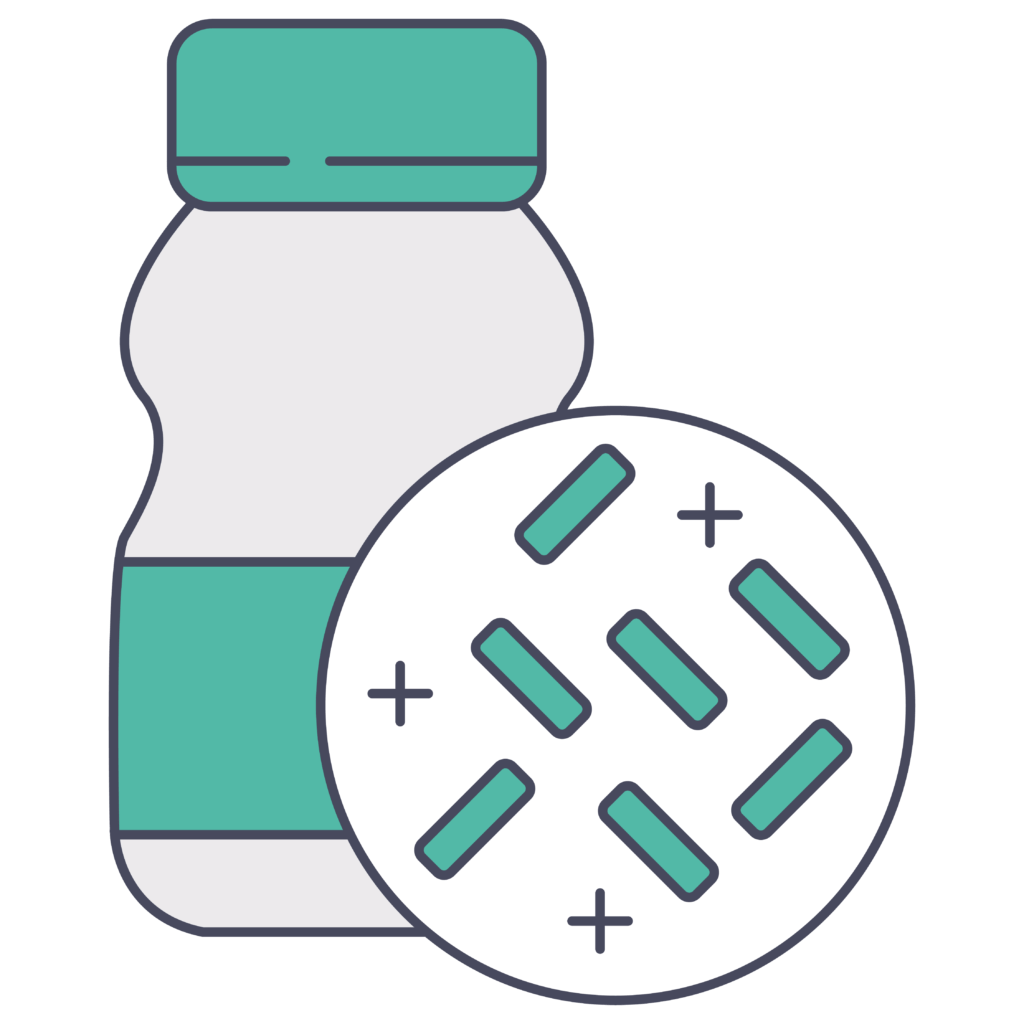The Microbiome and its contribution to human health
The gut microbiome is integral to the health of its host: while protecting against pathogens through colonization resistance, it interacts with human cells, directly or indirectly through microbially-produced bioactive molecules, regulating numerous biological pathways.1
A healthy microbiome is made up of a wide range of microorganisms which together play a key role in supporting immune system function and helping to prevent disease. Sometimes the delicate balance of the microbiome becomes disrupted resulting in a state known as ‘dysbiosis’ which is often linked to general poor health in the host.
Dysbiosis can have many causes including disease, stress, dietary problems and antibiotic administration. Treatment with biotic compounds helps to correct dysbiosis and promotes good health by restoring balance between the diverse microbial flora that make up the microbiome.1
Probiotics, Prebiotics and Synbiotics
A range of different biotics are available to both modulate and restore the intestinal ecosystem balance. The choice of which biotic to use depends on the microorganism, the indication, and the results demonstrated in clinical studies.
- Prebiotic is a substrate that is selectively utilized by host microorganisms conferring a health benefit2.
- Probiotics are live microorganisms that, when administered in adequate amounts, confer a health benefit on the host3.
- Synbiotics, can be ‘complementary’ or ‘synergistic’. A complementary synbiotic comprises a probiotic and a prebiotic working independently to achieve one or more health benefits whereas in a synergistic synbiotic the components are designed to work together, with the substrate being selectively utilized by the co- administered microorganism4.
Postbiotics: a new biotic category
Postbiotics are comprised of inanimate microorganisms, microbial cell components (including pili, cell wall components or other structures), and some microbial metabolites that have been shown to promote or preserve health. These compounds have demonstrated beneficial effects in controlled clinical studies across many therapeutic areas. Postbiotics modulate the resident microbiota, enhance epithelial barrier functions and regulate local immune responses. They can also influence human health beyond the gastrointestinal tract, impacting the immune system by modulating systemic immune and metabolic responses, and signalling via the nervous system.
Postbiotics are a key player in the biotic family, emerging as an important microorganism-derived tool to promote health. The term ‘postbiotic‘ had been used inconsistently in the literature, so, in 2021, ISAPP* published its Consensus Statement on the definition and scope of postbiotics. The ISAPP defines a postbiotic as ‘a preparation of inanimate micro-organisms and/or their components that confers a health benefit on the host’. 5
The Consensus stated that:
- Postbiotics are deliberately inactivated microbial cells with or without metabolites and cell components that remain stable for several years and offer reproducible results.
- Postbiotics are not viruses (including bacteriophages), vaccines, filtrates without cell components, purified microbial components or microbial metabolites.
- Their inherent stability means that they are more convenient than probiotics in terms of storage and transportation with no need for refrigeration.
- Postbiotics have proven health benefits across a range of indications in adults and children as demonstrated by many randomized, controlled studies.
- They have a good safety record in clinical practice and offer safety benefits in comparison to some live microorganisms.

All components of postbiotic contribute to its efficacy and health benefits.
In contrast to other biotics, with postbiotics the active molecules released from the cells in high concentration act directly on the microbiota and intestinal epithelial cells and, in heat-treated bacterial cells, immunomodulation may be greater owing to the variety of compounds they release.6 Furthermore, postbiotics avoid potential risks associated with live micro-organisms, have a good safety profile and are well tolerated by most patients, including newborns, vulnerable and elderly populations.
Postbiotics already play an important therapeutic role in gastro-intestinal conditions and their use could be extended into other areas of clinical medicine.
*International Scientific Association of Probiotics and Prebiotics
References :
1 Mills et al., Precision Nutrition and the Microbiome, Part I: Current State of the Science. Nutrients (2019). 2 Gibson et al., The International Scientific Association for Probiotics and Prebiotics (ISAPP) consensus statement on the definition and scope of prebiotics. Nat Rev Gastroenterol Hepatol (2017). 3 Hill et al., The International Scientific Association for Probiotics and Prebiotics (ISAPP) consensus statement on the scope and appropriate use of the term probiotic. Nat Rev Gastroenterol Hepatol (2014). 4 Swanson et al., The International Scientific Association for Probiotics and Prebiotics (ISAPP) consensus statement on the definition and scope of synbiotics Nat Rev Gastroenterol Hepatol (2020). 5 Salminen, S., Collado, M.C., Endo, A. et al. The International Scientific Association of Probiotics and Prebiotics (ISAPP) consensus statement on the definition and scope of postbiotics. Nat Rev Gastroenterol Hepatol (2021). 6 Piqué N. et al. Health Benefits of Heat-Killed (Tyndallized) Probiotics: An Overview. International Journal of Molecular Sciences 2019;20(10):E2534.
The world of “Biotics”
The intestinal microbiota sustains human health, through local and systemic activity. It can be influenced by pharmaceuticals, lifestyle, as well as by diet and related interventions, including certain foods (e.g. fermented foods), fibre-rich dietary regimens and biotics.

PROBIOTIC1
- Prescription medicine,Over-the-counter (OTC) medicine, yogurt, food supplements
- Live microorganisms
Live microorganisms that, when administered in adequate amounts, confer a health benefit on the host.1 Mechanisms vary according to specific strains. The most common effects include inhibition of potential pathogens and the production of useful metabolites or enzymes.
Such as Bifidobacterium animalis subsp. lactis XYZ

PREBIOTIC2
- Whole grains, fruits, vegetables and fibre-rich foods, food supplement
- Food for beneficial microorganisms
A substrate that is selectively utilized by host microorganisms conferring a health benefit on the host.2 Prebiotics act by enriching beneficial microorganisms such as Lactobacillus and/or Bifidobacterium spp. They have demonstrated positive effects on the gastrointestinal tract, cardiometabolism, mental health and bone integrity, among others.
Such as Inulin, galactooligosaccharides, fructooligosaccharides

SYNBIOTIC3
There are two categories of synbiotics:
- Mixture of probiotic + prebiotic
- A live microbe and a substrate for its growth
A mixture comprising live microorganisms and substrate(s) selectively utilized by host microorganisms that confers a health benefit on the host.3 Synbiotics can be ‘complementary’ or ‘synergistic’. A complementary synbiotic comprises a probiotic plus a prebiotic working independently to achieve one or more health benefits whereas in a synergistic synbiotic the components are designed to work together, with the substrate being selectively utilized by the co- administered microorganism.
Such as Inulin + Bifidobacterium animalis subsp. lactis XYZ

POSTBIOTIC4
- Prescription medicine, Over-the-counter (OTC) medicine, food supplements, infant formula
- Deliberately inactivated microorganisms, microbial cell components, and microbial metabolites
A preparation of inanimate micro-organisms, microbial cell components and microbial cell metabolites that can help to promote or preserve health.4
Postbiotics have demonstrated beneficial effects in controlled clinical studies in gastro-intestinal diseases and associated diarrhea. They work by modulating the resident microbiota, enhancing of epithelial barrier functions and regulating local immune responses.
Postbiotics can influence human health beyond the gastrointestinal tract, modulating systemic immune and metabolic responses, and signaling via the nervous system.
Such as Lactobacillus LB plus fermented culture medium, Lactobacillus casei, and Bifidobacterium bifidum. 4
References:
1 Hill et al., The International Scientific Association for Probiotics and Prebiotics (ISAPP) consensus statement on the scope and appropriate use of the term probiotic. Nat Rev Gastroenterol Hepatol (2014). 2 Gibson et al., The International Scientific Association for Probiotics and Prebiotics (ISAPP) consensus statement on the definition and scope of prebiotics. Nat Rev Gastroenterol Hepatol (2017). 3 Swanson et al., The International Scientific Association for Probiotics and Prebiotics (ISAPP) consensus statement on the definition and scope of synbiotics Nat Rev Gastroenterol Hepatol (2020). 4 Salminen, S., Collado, M.C., Endo, A. et al. The International Scientific Association of Probiotics and Prebiotics (ISAPP) consensus statement on the definition and scope of postbiotics. Nat Rev Gastroenterol Hepatol (2021).